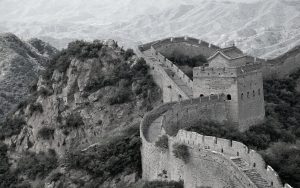
No, it is not visible from Outer Space, but that fact does not diminish the immensity of the Great Wall of China, which was approximately 13,000 miles long when it was originally built.
My husband and I were excited to visit the Great Wall, one of the most magnificent sights in China. The wall is easily accessible from Beijing, but our tour took us to a less touristy portion of the wall where we avoided the massive crowds that typically climb the steps. I did not know that the Great Wall is not the original. The first wall appeared more than 2,000 years ago, somewhere between 770-221 BC, to keep out invaders from other states. Between 221-207 BC, Emperor Qin tore down the walls between Chinese states and built the Great Wall to prevent invasion by barbarians (aka Mongols). Emperors in the Han and Ming Dynasty extended and rebuilt the walls to their magnificent state. (Parts of the wall are now underwater or have been destroyed, but the wall is still extremely impressive.)
 Unlike many other ancient great structures, much is known about the construction of the wall. Millions of people worked on the construction using basic supplies such as rope, wood, bricks, stone, soil, sand and other natural materials. The hard life required to build this 20-46-foot tall wall resulted in many deaths. Often the dead were simply buried within the walls and work continued without interruption. (Estimates put the deaths at well over 400,000 people.)
Unlike many other ancient great structures, much is known about the construction of the wall. Millions of people worked on the construction using basic supplies such as rope, wood, bricks, stone, soil, sand and other natural materials. The hard life required to build this 20-46-foot tall wall resulted in many deaths. Often the dead were simply buried within the walls and work continued without interruption. (Estimates put the deaths at well over 400,000 people.)
We walked well over 300 steep steps up and then, of course, we had to walk 300 steps down between each of the 3 watch towers we visited. We climbed somewhat slowly, especially by the latter steps; however, Chinese soldiers ran up and down the stairs on a routine basis. The majority of the walls are wide enough at the top for 10 men to walk side by side as they moved quickly from one fortification to another.

Our efforts were rewarded by beautiful views over the surrounding landscape. The Chinese guards definitely could see any approaching barbarians before they could breach the intimidating walls and the approximate 25,000 defensive fortifications that originally supported the walls. These structures took many forms such as guardhouses, watch towers, castles, and gates. Signal towers were used to send messages to the next tower via smoke or fire, depending on the time of day. By using these methods, communications concerning marauding barbarians could be quickly passed to military and royal leaders so steps could be taken to eliminate the intruders.
 In 1987, the Great Wall was named as a UNESCO World Heritage Site and is a great tourist draw for China. It is a symbol of solidarity within the wall and unity against the outside world. The Great Wall of China is a must-see site for visitors and is a monument to the immensity of all construction within China.
In 1987, the Great Wall was named as a UNESCO World Heritage Site and is a great tourist draw for China. It is a symbol of solidarity within the wall and unity against the outside world. The Great Wall of China is a must-see site for visitors and is a monument to the immensity of all construction within China.
– Candace Ahlfinger has loved traveling since she was little and has always been on the go whenever possible. Now she is retired and gets to do what she loves best… TRAVEL! Whether it’s traveling with her wonderful husband, or our children and grandchildren, traveling is a great experience that enriches her life. Because she always enjoys reading and hearing about others’ travel experiences, she wants to share her travels with the Ellis DownHome readers.






